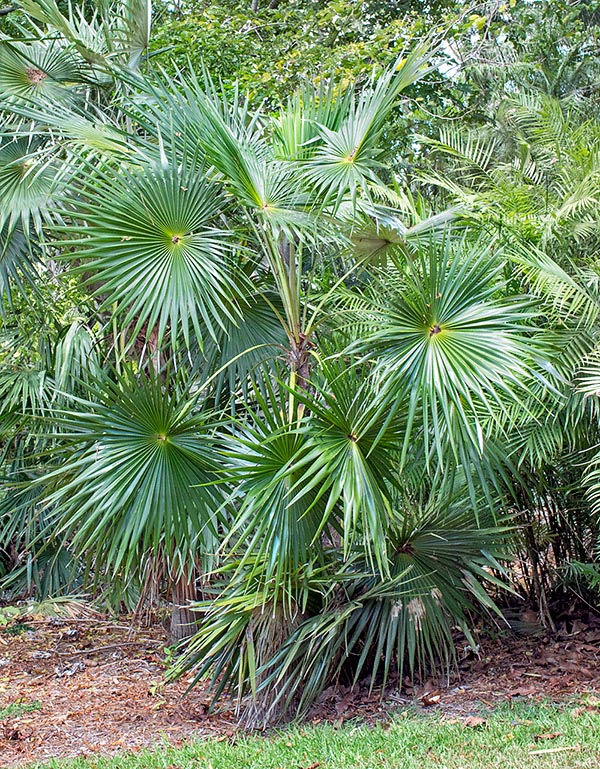Family : Arecaceae

Text © Pietro Puccio

English translation by Mario Beltramini

Native to Jamaica, Coccothrinax jamaicensis well stands the marine aerosols. Even 8 m tall and 20 cm stems. Perfumed inflorescences. The fuits are an important food resource for the avifauna © G. Mazza
The species is native to Jamaica, where it mainly lives along the coasts in semi-arid areas on calcareous or sandy rocky soils, from the sea level up to about 500 m of altitude.
The generic name originates from the combination of the Greek term “κόκκος” (coccos) = berry and of the name of the genus Thrinax, to which these plants resemble; the specific Latin name indicates its orgin place, Jamaica.
Common names: Jamaica silverpalm, Jamaican silver thatch (English).
The Coccothrinax jamaicensis Read. (1966) is an unarmed monoecious species with single stem, 6-8 m tall and of 8-20 cm of diameter, covered, excepting the oldest parts, by the fibrous foliar bases arranged in two layers, with 0,5 mm thick fibres. The leaves, on a 50-60 cm long and 1,5-2 cm broad petiole, are palmate, orbicular, of 80-140 cmof diameter, of intense glossy green colour above, silvery grey below and thickly covered by tiny scales. The foliar lamina is deeply incised in 35-38 linear-triangular segments with slightly bifid acuminate apex, flexible, 30-65 cm long at the centre and merged at the base for a length of 15-35 cm. Inflorescences between the leaves (interfoliar), 70-90 cm long, initially erect, then curved when in fruit, ramified with 4-7 primary spaced ramifications and of decreasing length towards the top, the lowest one, 8-15 cm long, with 14-40 rachillae 8-16 cm long. Hermaphroditic flowers, on a 0,3-0,6 cm long pedicel, of whitish colour, fragrant, with 7-15 stamina.
The fruits are globose, of 0,7-1 cm of diameter, of blackish purple colour when ripe, containing only one cerebriform seed of 0,5-0,7 cm of diameter.
It reproduces by seed in draining loam maintained humid at the temperature of 26-28 °C, with germination times of 2-4 months, the initial growth is rather slow.
Quite variable species, strictly related to the Coccothrinax argentata (Jacq.) L.H.Bailey (1939), whose rank of species in the past has been questioned by some botanists, is cultivable in the tropical, subtropical and, marginally warm temperate climate zones, where it can resist when adult to occasional decreases of temperature around the 0 °C for a very short period. It requires an exposition in full sun, and is not particular about the soil, even if poor, provided perfectly draining, with preference for the calcareous and sandy ones; well rooted it can resist to drought periods, even if it takes advantage of regular waterings in the zones characterized by long warm and dry summers. Moreover, it bears the saline aerosols, hence it can be utilized close to the sea.
The leaves are utilized for making mattings, bags, headgears and other artistic and of common use handicrafts. The fruits are an important food resource for the avifauna.
→ For general notions about ARECACEAE please click here.
